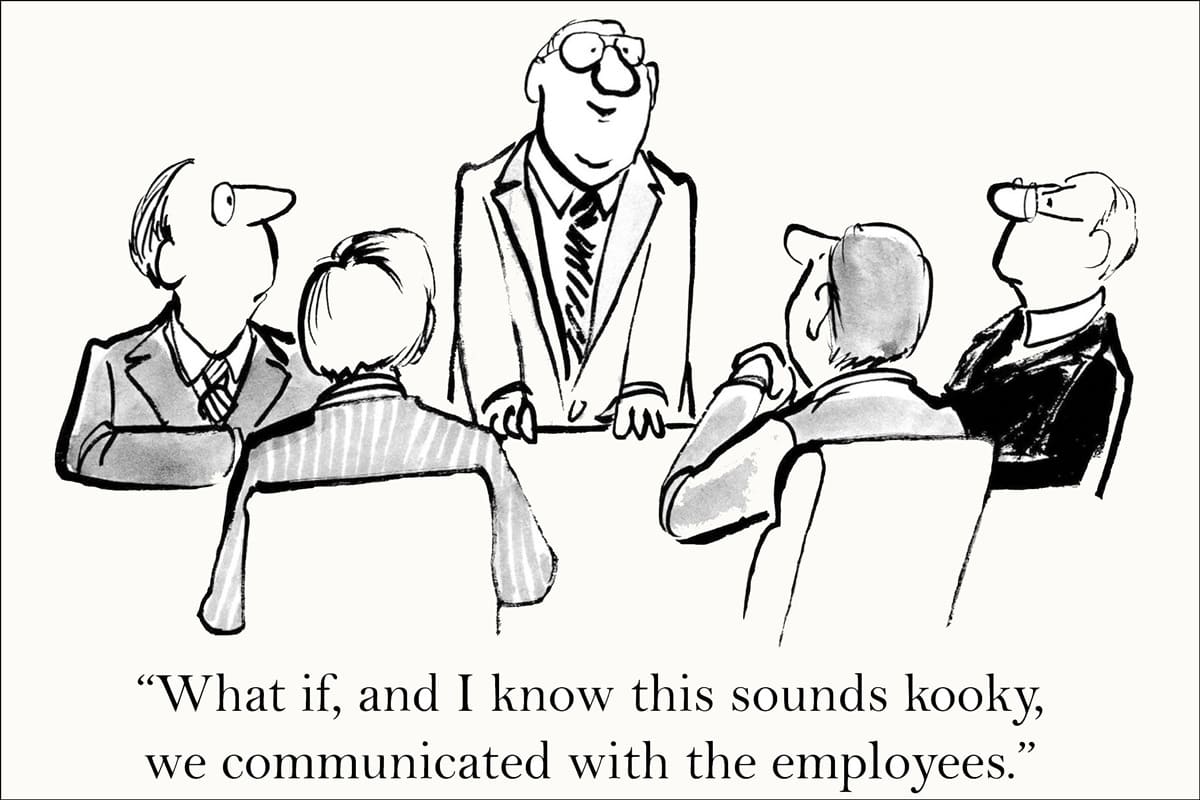Organisational Development | Change Management
Communication in change processes
From Sabine Walter, Head of netzwerk managementberatung | coaching
The way in which change processes are communicated is a key element for their success. Many managers underestimate this, do not communicate convincingly enough or communicate too little and contribute to the fact that the desired change goal is not achieved or is only achieved with considerable additional effort or that employees fall by the wayside during the transformation process and do not support the change. This article therefore addresses four questions: What needs to be communicated? What does a convincing change story look like? Which channels should be used for communication? How often should communication take place?
Reasons for willingness to change
Before we delve deeper into the topic of change communication, let's take a look at the prerequisites that must be fulfilled so that people are willing to accept or support change.
Reasons for willingness to change
Understanding the what and why
A central prerequisite for readiness for change is understanding the what and why:
- What should change?
- Why is this important?
- Why is it important to change now?
- What does that mean for me in concrete terms?
If this understanding is not given, emotional acceptance of the (planned) change can never be achieved.
Reasons for willingness to change
Emotional acceptance
Emotional acceptance is important to anchor a change permanently in everyday life. If a change or a planned change is not emotionally accepted but only cognitively understood, there will always be conscious or unconscious resistance.
Emotional acceptance arises when people feel that the new does not pose a threat but avoids risks or even opens up opportunities.
Reasons for willingness to change
Trust
Trust in change processes is central. Where there is trust, there are no fears. Trust gives security and supports the emotional acceptance of the new. What should trust consist of?
- Into the what and why: does what we want to change make sense?
- In the people who act: Are the people communicating the change or driving the process credible?
- Into the promised result: Is the promised result realistic?
- In the process: Will we achieve the promised result the way we are going?
Change communication
Communication as the key to readiness for change
You can already see from the questions that need to be answered in order to achieve readiness for change that convincing change communication contributes significantly to this. If the communication is poor or insufficient, the willingness to change is damaged, resistance to the new grows or cannot be rebutted and the risk that the change project will fail increases.
According to a study by the management consultancy Mutaree, 3 points in particular determine whether change projects are successful. All of them have to do with communication:
- Urgency: Understanding that there is no alternative to change at this time, so action must be taken now.
- Understandability: the ability to send messages that are received and understood; and
- the ability to listen to, take seriously and respond to individual stakeholder needs
So, creating time and space to ask questions, to express concerns is just as much a part of it as the ability to respond to them in an understandable and emphatic way.
Change communication
Elements of effective change communication
The prelude to effective change communication is made up of six central elements:
- Target image: Where do we want to go?
- Reason: Why do we want to go there?
- Urgency: Why are we setting out at this time?
- Concrete change: What is the concrete change for the respective stakeholder, e.g. the employees?
- Next steps: Where do we go from here?
- Appeal: What am I asking you?
If these aspects are communicated in an understandable way, you help those affected by the change to understand the what and why. This understanding helps build confidence in the change and minimises fear and uncertainty.
Change communication
Build a change story
There are different ways to put these six elements in a meaningful order so that a convincing change story emerges. We present two variants:
Variant 1
- Change Reason: "You all know the problem / situation ..."
- Concrete change: "Now we have the chance ...
- Target image (positive future): "This will make us..." in the future.
- Urgency: "Why are we addressing the issue now? At the present time ... If we were to deal with it only next year, there is a risk that ..."
- Next steps: "Next, therefore, we will..."
- Appeal & repetition of benefit: "I ask you ... This will enable us to succeed in the future ..."
Variant 2
- Target image: "It is our goal .... ."
- Change Reason: "Through this we achieve ... (benefit)".
- "It is important that we start now because ..." (Risks that are avoided if the status quo is maintained or an opportunity that is offered by the change at the current time).
- Concrete change: "For you, this means concretely ..."
- Next steps: "The next step will therefore be ..."
- Appeal & repetition of the benefit: "Let us ... so that in the future we ...".
Make sure that the language is clear and understandable. Let Plasticiser such as "actually", "normally", "possibly". This weakens the message and conveys that you as the sender are not fully convinced of what you are saying.
Change communication
Speak appropriately to the addressees
The ability to respond to the questions and concerns of the respective stakeholders is also reflected in communication that is appropriate for the target group. The focus of the change story is set differently depending on the counterpart. We start from two basic types:
- the change agents: "Finally something new. It was already boring.
- the preservationists: "Let's not have too many new things. It has worked out well so far.
As you read these lines, you probably have concrete colleagues in mind whom you can easily assign to the two types of change. You have to address each of these two types differently, even if you are conveying the same information. To give you an impression of the differences in addressing the different types, I will give you two examples:
| Change agent | Keeper |
| "We are introducing a revolutionary system." "The new process will turn everything upside down." (addresses the need for something new) | "We are introducing a proven system." "The future process will run even more safely." (addresses the need for security) |
As you can see, the wording determines how the messages affect the recipients. It is important that all elements you communicate are true. You only emphasise different aspects specific to the target group.
Change communication
Transparency throughout the change process
Initial communication at the beginning of a change process is not enough. It is much more important to continuously create transparency in the course of the change process.
This includes convincingly communicating intermediate statuses and intermediate successes. It helps if initial aspects are also taken up again in this communication.
- Already known:
- Goal: "As you all know, it is our goal ..."
- Urgency: "For us to achieve this, it was important to start this journey at the current time."
- First successes:
- What have we already done / what has already changed?
- With what positive effect?
- Next steps:
- What still needs to be done?
- What next steps do we take and when?
Change communication
Central channels for successful change communication
In order to accompany a change process well in terms of communication, various channels have proven their worth. These include:
- Townhall
- Intranet
- Team meetings
- 1:1
Each channel has different strengths, so it should be used in a way that brings out those strengths.
Townhall
In the Townhall Meeting you reach very many members of an organisation at the same time. In the Townhall meeting you have both the opportunity to convey information and to answer questions in direct contact. This helps to avoid misunderstandings, clarify uncertainties and send key messages again and again, so that you stick with those involved and affected.
Intranet
All employees are also reached via the intranet. It offers space to provide information in different formats, such as text, video or presentation format. However, it is not possible to answer questions in direct contact. However, the intranet can be used to open a channel through which questions can be asked and answered, for example, on a FAQ page. The advantage of the intranet is that information can be accessed by employees over a longer period of time and independent of time and space.
Team meetings
Similar to the Townhall, the Team Meeting offers a direct exchange and space to explain messages in a small circle. This usually allows for communication that can be even better targeted to the small group of addressees. Space to answer questions is also given.
The 1:1
Since the 1:1 is a bilateral conversation, it can be very specific to the individual's concrete needs and questions. The disadvantage is that many 1:1s would have to be conducted in order to reach the group of participants that can be reached via a townhall. Therefore, the 1:1 is only a complementary communication channel in change processes.
Some of you will miss e-mail as a central communication channel. Of course, it is also a way to send information to many recipients at the same time. However, the room for misunderstanding is large, as e-mails offer no room for direct queries. If communication is only done via e-mail, it can happen that central information gets lost in the abundance of daily e-mails. We recommend using e-mails very selectively in the context of change communication.
Change communication
Frequency of change communication
In order to anchor the central messages of your change story in your organisation, it is elementary that you communicate these messages again and again through the different channels.
It is important that the different elements of communication interact with each other. This is the only way to ensure that the recipients understand the what and why of the change and internalise that the change is not a threat but avoids risks or brings concrete benefits.
Conclusion Change Communication
The quality of change communication is decisive for the success of change processes.
Willingness to change arises when the following conditions are met:
- The what and why of change is cognitively understood.
- The change is also accepted emotionally because it does not pose a threat or even avoids risks or brings concrete benefits.
- There is trust in the what and why, the people acting, the promised result and the process.
To fulfil these three conditions, communication is a central key.
Another success factor in change processes are role models. If you would like to read more about this, you will find information in the article "Staff change!"



